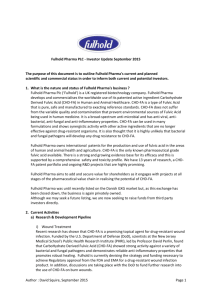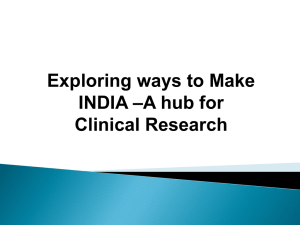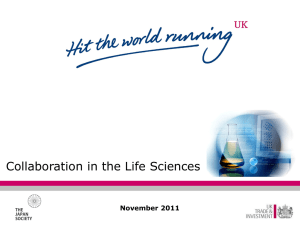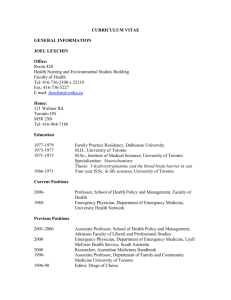Health & Pharmaceuticals - University College
advertisement
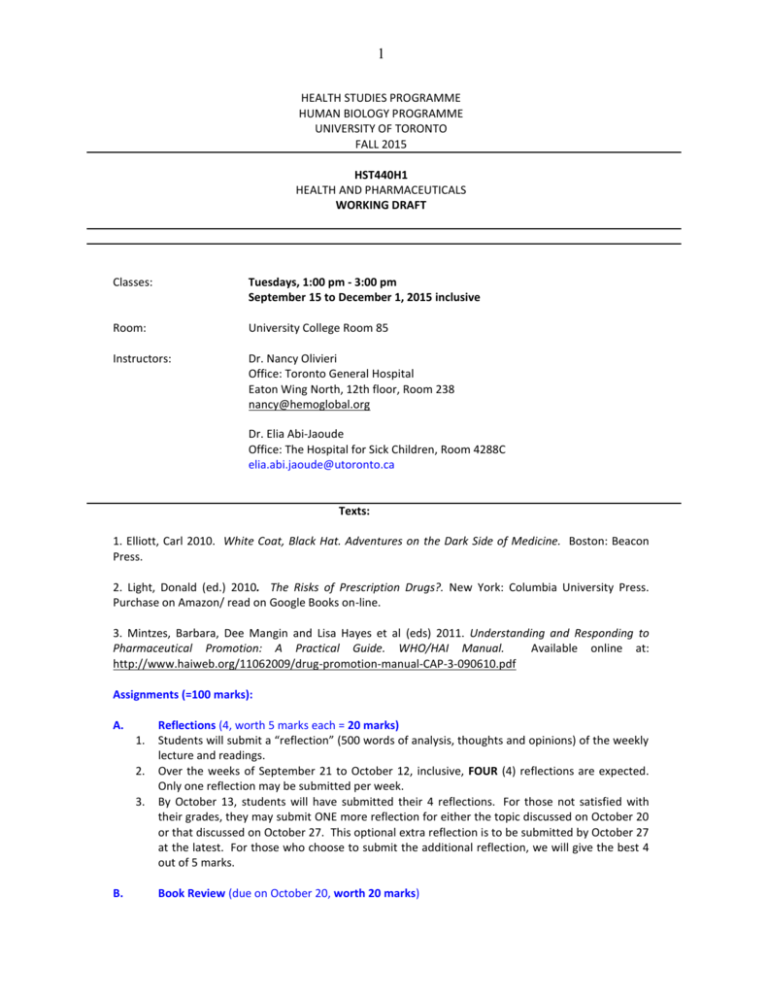
1 HEALTH STUDIES PROGRAMME HUMAN BIOLOGY PROGRAMME UNIVERSITY OF TORONTO FALL 2015 HST440H1 HEALTH AND PHARMACEUTICALS WORKING DRAFT Classes: Tuesdays, 1:00 pm - 3:00 pm September 15 to December 1, 2015 inclusive Room: University College Room 85 Instructors: Dr. Nancy Olivieri Office: Toronto General Hospital Eaton Wing North, 12th floor, Room 238 nancy@hemoglobal.org Dr. Elia Abi-Jaoude Office: The Hospital for Sick Children, Room 4288C elia.abi.jaoude@utoronto.ca Texts: 1. Elliott, Carl 2010. White Coat, Black Hat. Adventures on the Dark Side of Medicine. Boston: Beacon Press. 2. Light, Donald (ed.) 2010. The Risks of Prescription Drugs?. New York: Columbia University Press. Purchase on Amazon/ read on Google Books on-line. 3. Mintzes, Barbara, Dee Mangin and Lisa Hayes et al (eds) 2011. Understanding and Responding to Pharmaceutical Promotion: A Practical Guide. WHO/HAI Manual. Available online at: http://www.haiweb.org/11062009/drug-promotion-manual-CAP-3-090610.pdf Assignments (=100 marks): A. 1. 2. 3. B. Reflections (4, worth 5 marks each = 20 marks) Students will submit a “reflection” (500 words of analysis, thoughts and opinions) of the weekly lecture and readings. Over the weeks of September 21 to October 12, inclusive, FOUR (4) reflections are expected. Only one reflection may be submitted per week. By October 13, students will have submitted their 4 reflections. For those not satisfied with their grades, they may submit ONE more reflection for either the topic discussed on October 20 or that discussed on October 27. This optional extra reflection is to be submitted by October 27 at the latest. For those who choose to submit the additional reflection, we will give the best 4 out of 5 marks. Book Review (due on October 20, worth 20 marks) 2 1. 2. This is a 1500 ± 200 words review of a book; Books to be reviewed are to be drawn from a list provided (“Book List”) C. In-class student presentations (30 marks) 1. Each student along with 4 to 5 other students will be assigned a topic that extends analysis to new topical, ethical, and epidemiologic areas. This round of presentations will begin in November for 4 weeks. 2. On Tuesday September 29, these topics will be assigned. D. Final essay (30 marks). Schedule of Lectures 1st Lecture: Tuesday, September 15, 2015: Health And The Pharmaceutical Industry: an overall view: what do we know and understand? What is fact? What is myth? Discussion led by: Professor Olivieri This lecture will be a general introduction to the course. The central problematic will be discussed: what the course is about; discussion of the outline, readings, assignments, presentations, and the final essay will be provided. The industry that produces drugs for human health presents itself as a unique combination of humanitarian enterprise wedded to capitalist business practices and goals. How successful is this synthesis? And how closely does the rhetoric correspond to the reality? A growing number of critics, representing health professionals, patients and patient advocates, government watchdogs and industry whistle-blowers have found the high-minded language of Pharma’s stated goals departing radically from the actual practices observed. These widening gaps are manifest on a variety of levels: ethical, legal, and scientific; and at every stage in the process of drug development. Each drug can been seen as having a life history: from laboratory development, to construction of clinical trials, to submission to government for evaluation and approval, to writing of scientific results, to marketing to doctors and to the public, and post-market monitoring of efficacy and of side-effects and adverse events. This course will explore the expanding bodies of evidence that document the ways in which Pharma currently operates in the intersecting worlds of science, ethics, business, and human health. Required reading: None assigned. 2nd lecture: Tuesday, September 22, 2015: The fundamental problem of conflicts of interest: in development, prescription, promotion, and marketing of drugs. In class movie: Big Bucks, Big Pharma (45 minutes) Discussion led by: TBA A crisis in medicine and research? Consider the following: 3 Why have former editors of world’s most prestigious medical journals expressed alarm about relations between the pharma industry and medicine using terms like “corruption”? What should we make of research in leading media such as Bloomberg Markets which headline “Big Pharma’s Crime Spree” in relation to civil and criminal findings in the billions of dollars of penalties? Why have medical ethicists recently called for legal penalties for ghost-writing/guest-authorship practices, using terms such as “fraud” and “racketeering?” Why has a Canadian Member of Parliament written a book called “Death by Prescription”, about his daughter’s death from a prescription drug (Prepulsid)? Why did the associate director of drug safety at the Food and Drug Administration testify before the US Congress in 2005 against his own agency and hold it responsible for the “single greatest drug safety catastrophe in the history of this country or the history of the world”? The ways that Pharma and medicine intersect are extremely complex. As we begin to unravel these complexities, we turn to the work of Carl Elliott, a physician, ethicist, and courageous activist, to shine light on some of the darker corners of the medical profession as it actually functions today. We begin our examination by looking at Elliott’s own awakening to the seriousness of the crisis in medicine. The Donald Light chapter offers an introduction to the key issue of harm, to consumers/patients and harm to bio-medicine and its credibility. Light provides an overview of the extent and types of harm. Elliot documents the institutional arrangements (and others) which allows harm to proliferate. Required reading: Elliott, Carl 2010. White Coat, Black Hat. “Introduction” pp. ix-xvi. Elliott, Carl 2010. White Coat, Black Hat. Chapter 3: “The Detail Men” Pp. 51-73; & Chapter 4: “The Thought Leaders” pages. 75-108. HAI Manual Chapter 1; Mintzes B et al. “Promotion of medicines and patient health” Recommended reading: Light, Donald 2010. The Risks Of Prescription Drugs. Chapter 1 Bearing the risks of prescription drugs, pp. 1-39 HAI chapter 3: Analyzing pharmaceutical advertisements in medical journals HAI chapter 4: Pharmaceutical reps Schafer A. Biomedical conflicts of interest: A defense of the sequestration thesis-learning from the cases of Nancy Olivieri and David Healy. J of Med Ethics 2004;30:8-24. (16 pages) Stossel TP. Has the hunt for conflicts of interest gone too far? Yes. Brit Med J 2008; 336: 476-477. (1 page) Lee K. Has the hunt for conflicts of interest gone too far? No. Brit Med J 2008; 336: 477-478. (1 page) Wazana A. Physicians and the pharmaceutical industry: Is a gift ever just a gift? JAMA 2000;283: 373-80. 4 (7 pages) Willman D. Stealth Merger: Drug Companies and Government Medical Research. Los Angeles Times. Dec 7, 2003: A1, A32-33. (20 pages) Stossel TP. Response to AMA's council on ethical and judicial affairs draft report on “ethical guidance for physicians and the profession with respect to industry support for professional education in medicine.” Medscape J Med 2008;10:137-43. (7 pages) Brody H. A reply to Thomas Stossel on the AMA-CEJA draft report. Medscape J Med 2008;10:154-6. (2 pages) Multiple Authors responding to Stossel TP, N Engl J Med 2005. Academic-industrial relationships: Correspondence (Howard Brody, Thomas Stossel, Ehud Arbit). N Engl J Med 2005; 353:2720-2. (2 pages) Steinbrook R. Financial conflicts of interest and the NIH. N Engl J Med 2004; 350:327-330. (3 pages) 3rd lecture. Tuesday, September 29, 2015: (i) (ii) Big Pharma and Medical Education Ghost Authorship and “Ghost-writing” In Industry-sponsored Research Discussion led by: Ms. Adrienne Shnier, Health Policy and Equity, School of Health Policy and Management, York University, Toronto, Canada Big Pharma and Medical Education Conflicts of interest with industry may occur in medical education in the classroom, in the conduct and reporting of research, at the bedside, and in the treatment of patients. The education of medical students should be based on the best clinical information available, unbiased by the commercial interests of industries marketing pharmaceutical or other health products. In many Canadian medical schools, students are taught by faculty who work in partnership with industry, e.g., receive research grants from companies, serve on companies’ speakers’ bureaus or advisory committees, or own shares in companies. The financial relationships of faculty with industry may affect, or reasonably appear to affect, the integrity of their academic or publishing interests, professional medical opinions, and the information that they disseminate to medical students. These relationships between medical faculty and industry represent conflicts of interest and compromise not only the public’s confidence and trust in medical researchers and universities, but also the potential for robust, evidencebased clinical education for medical students. Ghost Authorship and “Ghost-writing” In Industry-sponsored Research The publication of research articles in refereed journals is held up as the gold-standard in academic achievement and advancement. In most non-medical fields, claiming authorship of work not written by the listed author is a major breach of academic ethics, and penalties can be severe. Yet in medical journals a significant percentage of major articles are written by anonymous professional writers (usually at the direction of Pharma companies) and then “authored” by senior academic researchers. Until recently this was considered normative, and not ethically questionable. Today’s readings and lecture focus in some part on the ghost/guest authorship in publishing pharmaceutical research. Required Reading Shnier A., Lexchin J., Mintzes B, Juttel A., and Holloway K. Too Few, Too Weak: Conflict of Interest Policies at Canadian Medical Schools. PLOS ONE 2013: 8(7): e68633. 5 Elliott, Carl 2010. White Coat, Black Hat. Pp. 1-23 and Chapter 2: “The Ghosts”, Pp. 25-49. Recommended reading: Medical Education Relman AS. Separating Continuing Medical Education From Pharmaceutical Marketing. JAMA 2001; 285: 2009-2012 Elliott C. Pharma Goes to the Laundry: Public Relations and the Business of Medical Education. Hastings Center Report. September-October 2004. Campbell EG, Weissman JS, Ehringhaus S et al. Institutional academic industry relationships. JAMA 2007; 298(15):1779-1786 (doi:10.1001/jama.298.15.1779) http://jama.ama-assn.org/cgi/content/full/298/15/1779 Brennan TA, Rothman DJ, Blank L et al. Health Industry Practices That Create Conflicts of Interest: A Policy Proposal for Academic Medical Centers. JAMA 2006; 295(4):429-433 (doi:10.1001/jama.295.4.429) http://jama.ama-assn.org/cgi/content/full/295/4/429 Mello MJ, Clarridge BR, Studdert DM. Academic Medical Centers’ Standards for Clinical-Trial Agreements with Industry. N Engl J Med 2005;352: 2202-10. Ghostwriting Anekwe, T. (2009). Profits and Plagiarism: The Case of Medical Ghostwriting. Bioethics, 24 (6), 267-272. Barbour, V. (2010). How Ghost-Writing Threatens the Credibility of Medical Knowledge and Medical Journals. Haematologica, 95 (1), 1-2. Elliott, C. (2010a). Chapter 2: The Ghosts. In C. Elliott, White Coat Black Hat: Adventures on the Dark Side of Medicine (pp. 25-49). Boston: Beacon Press. Fugh-Berman A (2010). The Haunting of Medical Journals: How Ghostwriting sold “HRT” PLoS Medicine 7 (9): 1-11. Gotzsche, P. et al. (2007). Ghost Authorship in Industry-Initiated Randomised Trials. PLoS Medicine, 4 (1), 47-52. Gotzsche, P. et al. (2009). What Should be Done to Tackle Ghostwriting in the Medical Literature? PLoS Medicine, 6 (2), 0122-0125. Grassley, C. (2010). Ghostwriting in Medical Literature. Senate Committee on Finance. United States Senate. http://www.grassley.senate.gov/about/upload/Senator-Grassley-Report.pdf Lacasse, J. & Leo, J. (2010). Ghostwriting at Elite Academic Medical Centres in the United States. PLoS 6 Medicine, 7(2): 1-4. Ngai, S., Gold, J., Gill, S. & Rochon, P. (2005). Haunted Manuscripts: Ghost Authorship in the Medical Literature. Accountability in Research, 12, 103-114. Sismondo S (2007) Ghost Management: How Much of the Medical Literature Is Shaped Behind the Scenes by the Pharmaceutical Industry? PLoS Med 4(9): e286. 4th Lecture: Tuesday, October 6, 2015: The role of government regulation in approval and marketing of drugs. Discussion led by: Dr. Joel Lexchin, Professor, School of Health Policy and Management, Faculty of Health, York University. All members of the public eventually become patients in need of some combination of products from Pharma. In medicating ourselves we count on government regulatory agencies to evaluate all potential medications and to approve only those that have proven efficacy and an absence (or at least low incidence) of serious side effects. Then how do we account for the all too numerous drugs approved and then taken off the market because of adverse side effects, up to and including death. The NSAID painkiller Vioxx, passed all regulatory hurdles and was approved for sale to the public. It was estimated to have caused between 40,000-60,000 excess deaths in the United States before it was removed from the market in 2004. Today`s lecture by Dr. Lexchin examines in detail the ways in which agencies like FDA and Health Canada, do or do not live up to their mandate and meet the rightful expectations of the public to have medicines that are effective and affordable and above all, safe. Required Reading WHO/HAI chapter 3 Lexchin J. Analyzing pharmaceutical ads in medical journals and chapter 6: Learning how not to do the pharma industry tango. WHO/HAI chapter 7 Zinganshina and Lexchin. Regulation of pharmaceutical promotion: Why does regulation matter? Light, Donald 2010. Chapter 2: The Food and Drug Administration: Inadequate Protection from Serious Risk. Pp. 40-68 Herder, Matthew 2011. Unlocking Health Canada`s cache of trade secrets: mandatory disclosure of clinical trial results. CMAJ 2012;184(2): 194-9. 5th Lecture: Tuesday, October 13, 2015: Pharmacare: An idea long overdue Discussion led by: Professor Marc-André Gagnon School of Public Policy and Administration Carleton University Required and recommended readings: TBA 7 6th Lecture: Tuesday, October 20, 2015: Practical approaches to addressing the harms associated with current practices of drug evaluation and prescribing Discussion led by: Dr. Derelie Mangin 7th lecture: Tuesday, October 27, 2015: The influence of the pharmaceutical industry in psychiatry, and how to mitigate it. Discussion led by: Dr. Elia Abi-Jaoude Psychiatry is the area of medicine that has reputedly been the most influenced by the pharmaceutical industry. In this session, we will look at specifics of this influence in psychiatric research and clinical practice. We will draw on evidence from the published literature, as well as from internal industry documents. Subsequently, we will discuss ways to mitigate commercial bias so psychiatric care can be delivered in an independent fashion to the benefit of patients. Required Reading Spielmans, G. I. & Parry, P. I. (2010). From Evidence-based Medicine to Marketing-based Medicine: Evidence from Internal Industry Documents. Journal of Bioethical Inquiry, 7, 13-29. Paris, J. (2012, April 4). Over-prescribing: a worrisome trend. The Montreal Gazette Recommended Reading Moncrieff, J., & Timimi, S. (2013). The social and cultural construction of psychiatric knowledge: an analysis of NICE guidelines on depression and ADHD. Anthropology & medicine, 20(1), 59–71 Bracken, P., Thomas, P., Timimi, S., Asen, E., Behr, G., Beuster, C., … Yeomans, D. (2012). Psychiatry beyond the current paradigm. The British journal of psychiatry: the journal of mental science, 201(6), 430–434 Schiff, G. D., Galanter, W. L., Duhig, J., Lodolce, A. E., Koronkowski, M. J., & Lambert, B. L. (2011). Principles of conservative prescribing. Archives of Internal Medicine, 171, 1433-1440. 8th Lecture: Tuesday, November 3, 2015: Student Presentations 1 and 2 9th Lecture: Tuesday, November 17, 2015. Student Presentations 3 and 4 10th Lecture: Tuesday, November 24, 2015: Student Presentations 5 and 6 11th Lecture: Tuesday, December 1, 2015: Student Presentations 7 12th Lecture: Tuesday, December 8, 2015: LAST DAY OF CLASS Summary discussion: where do we go from here? 8


